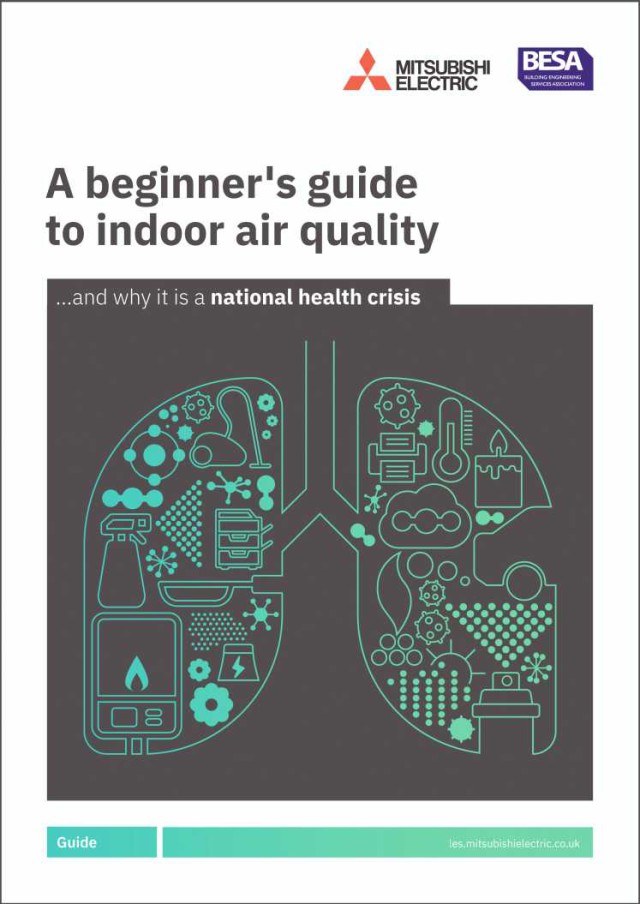Opening offices with a breath of fresh air

It’s likely that people will be returning to offices soon so now is an ideal opportunity to address the issue of air quality inside our buildings. How can you prepare buildings for the arrival of staff, whether in co-working spaces or as the sole tenants asks Mark Grayston, Product Manager, Mitsubishi Electric.
We spend over 90% of our time indoors, and pollution is estimated to be up to 5 times worse than the air outside, so indoor air quality is an important issue in its own right - especially given the spotlight currently on the importance of providing safe work environments.
Modern buildings are designed to be airtight to help lower their carbon footprint but it can lead to some unintentional problems. A lack of ventilation in an airtight building will mean the indoor environment quickly becomes stale and stuffy. This build-up of excess moisture and CO2 can result in illness and the growth of mould in the building.
There are also many pollutants which are generated from inside the workplace itself. Cleaning products, solvents, dust, carpet fibres, photocopy residues and building materials, otherwise known as volatile organic compounds (VOCs), create quite an unhealthy cocktail of contaminants which eventually filter throughout the office.
A poorly ventilated office means a subsequent increase in CO2 levels. Worryingly, research is suggesting that levels as low as 1,000 parts per million can result in health problems and poor cognitive functioning even if exposed for only a few hours.
There is also research to link indoor air quality (IAQ) to productivity at work. A YouGov survey commissioned by the Building Engineering Services Association (BESA) found that almost 70% of office workers believed poor air quality had a negative impact on their day-to-day productivity. 68% of these experienced lapses in concentration whilst 67% reported suffering from fatigue whilst at work.
Of course, we now have the added risk of COVID-19, creating another air quality issue which must be tackled for the sake of employee health.
Effective ventilation should be the starting point when looking to improve IAQ. Whether by natural or mechanical means, ventilation should remove stale and humid air whilst circulating fresh air from outside of the office.
Mechanical Ventilation with Heat Recovery (MVHR) systems can deliver the required ventilation but do so in an energy efficient way, so that the energy used to heat the indoor air, isn’t just ‘thrown away’ when the fresh air is brought in.
They capture up to 80-90% of the heat energy from the stale air to bring the incoming air nearer to the desired temperature, meaning less energy is required to achieve room temperature.
For some buildings, there will be a drive to increase the rate at which fresh air is introduced into the office – which is also what future Building Standards are suggesting. This in turn adds additional strain to the system by needing it to work at higher levels.

Being mindful of the operating capacity and the time running at these levels, increased service and maintenance schedules will be required to ensure a reliable and effective system.
There are recommendations from REVHA on how to operate mechanical ventilation systems to prevent spreading COVID-19. REVHA recommends that systems should not be switched off and should instead operate at a lower speed when the building is not in use.
When employees return to the office, ventilation should operate at a nominal speed at least 2 hours before the building opens, and switch to a lower speed 2 hours after the building has closed. Central recirculation is not recommended due to the risk of recirculating contaminated air.
Finally, it’s also worth talking about air conditioning because in response to the global pandemic, air conditioning manufacturers have introduced air purification technologies that can guarantee to inhibit SARS-CoV-2.
These include units that can bolt-on to indoor units with powerful air purification which can filter out harmful airborne pollutants and pathogens, to help safeguard occupants against COVID.
Our own Plasma Quad Connect system for example, offers bolt-on purification across a wide range of new and existing installations. The technology has also been found to be effective against bacteria, dust, viruses, mould and allergens such as pollen, in addition to microscopic particles down to PM2.5, thereby helping improve the safety and comfort levels for building occupants.
As society looks to get the economy working once more, it is uncertain what the new ‘normal’ will look like, but offices will still be needed and we therefore have to make them as safe, comfortable and energy efficient as possible.
To help anyone understand the issues around IAQ, Mitsubishi have collaborated with BESA to produce a free basic guide to IAQ, which can be downloaded here:







